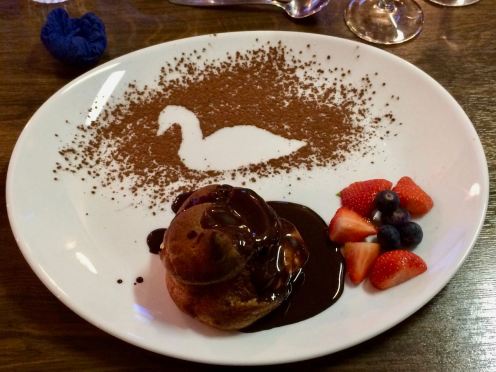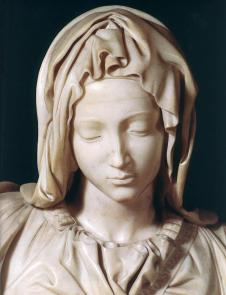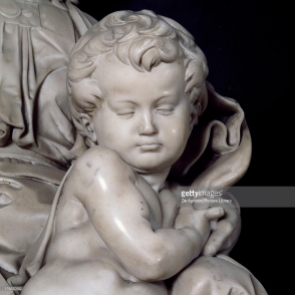The previous post concluded with comments about the last rider along the canal – a European cyclist who would want fresh bread at the start of each day.
We all want a long ride – good food every day, wonderful friends… But as we left Tournai, it was clear that our two-week ride was nearing its final stage.
As we continued into Belgium, we were leaving the land of “wine culture.” We had entered the region of “beer culture.” What would be a more natural celebration than a beer tasting on our barge one evening? And, which crew member would be the natural presenter of an historical perspective of traditions of beer which go back to fermented fruit juice? (Yes, there is cherry beer!) The choice was the engineer, Michael, who was in charge of all things mechanical, and who shared pilot duties with the captain. Like everyone on board, his education was broad and deep. And, his respect for the traditions of food and drink was clear.

Beer Tasting and Laughter
If you ride 50 kilometers each day, you need good food to start the journey. And, at the end of the day, a glass of wine or beer can be helpful to ease the pain of a few sore muscles…
At our stop in Ghent we found not only local beers, but a perspective on Europe’s ongoing efforts to merge the old and the modern. Part of this challenge is transportation: pedestrians and bikes with cars and trams. Another part of the challenge is in the area of architecture. Integration of Renaissance / Gothic with functional modern.

A Modern City
Of course no visit to a European city is complete without visits to the twin monuments of historic urban life: a cathedral (architecture of worship) and military technology (architecture of warfare).

Christan explains the Red Gun (Dulle Griet)
Red Gun from 15th Century
Into Bruges / Brugge
Our last ride was from Ghent to Bruges. From a bustling modern city with a storied past into a meticulously preserved city that was once “the Venice of the North.”
Our ride was unusually swift and gentle – a quick stop at a rural cafe for coffee and a mid-morning croissant. We cycled past many fields of placid cows that seemed to be posing for pictures of bucolic boredom. Even Vincent Van Gogh would have had difficulty finding aesthetic substance in such a bland swath of farmland.
Our ride was mercifully shortened by a tailwind. Without the hindrance of traffic or pedestrian congestion, we maintained a record pace. I finally used the highest gear on my bike. (It should be noted that on an earlier day, one of the riders – sprinting to the front of the peloton – announced that her progress had been slowed by “running out of gears.” Such is the variance of skill and speed in a 24-person tour.)
Before our lunch stop, we reached Bruges – and, our arrival was a form of celebration: a two-wheeled, two-week journey completed. A short stop for a picture of our 3 leaders: Christan, one bike leader; Birgit, our BAC leader; Ilaria, our other bike leader.

Christan, Birgit, and Ilaria
We had time to hear a history of Bruges from Christan – and, tour a few shops. Yes, a once vibrant “Venice of the North,” has become a well-appointed nouveau shopping city for tourists. It survived a period of suspended animation from about 1500, when the river to the sea silted in, to its post-World War II status as a well-preserved artifact of early Renaissance Europe.
Bruges – Golden Age: (12th to 15th centuries): As commerce increased from the river, and as canals were built, a city inside fortified walls was constructed. The street plan of the inner city remains the same to this day.
The Bourse opened in 1309 (most likely the first stock exchange in the world) and developed into the most sophisticated money market of the Low Countries in the 14th century.
In the last half of the 19th century, Bruges became one of the world’s first tourist destinations attracting wealthy British and French tourists. The historic city center is now a prominent World Heritage Site of UNESCO.
After our personal tour and shopping, we returned to the Zwaantje for our last supper; A special meal savored with great camaraderie and several toasts to a group that had developed the rapport of a close-knit family.

Dessert

Bruges Brothers (Christan & Arthur) with Suzie

Group photo – (refer to Official Trip Report below)
Beyond the Tour
One question in any travel adventure is how much time to spend in each location. On a bicycle tour, much of that question is answered: one day per town. And, really, part of one day. (If it’s a rest day, maybe time for some exploration…)
Joy and I decided that we might never return to Bruges. Given its significance and charm, extra days seemed sensible. How could we leave this enchanting city without sampling its well-deserved culinary reputation: moules et frites and chocolate?

moules et frites
Our visit to the Markt (“Market Square”) enabled us to visit a chocolate fête in the main exhibit hall. We encountered dozens of unique presentations of the magical dark concoction. More are produced in Belgium than anywhere else in Europe. Champagne with chocolate (less sweet than you might think), hazelnuts with chocolate (better than you would suspect), carefully hand-crafted chocolate pieces (more expensive than what you might spend), anatomically correct artifacts of chocolate (more erotic than what you would find in a U.S. candy store)…
And, of course, informative conversations with the vendors. A serious discussion of chocolate in Belgium is much like a serious discussion of wine in France: the word, terroir, is always mentioned. People wax poetic when describing the DNA of a specific plant, the chemical attributes of the soil, the unique advantages of a specific climate, the loving care used in the harvest… “This is why our product is so unique. You must taste a little more…”
A little more tasting of everything, including beer.

a flight of 6 beers
Success as a financial center often results in success as a center for artistic excellence. That was true at the height of Bruges’s success. It is still true today. Bruges is one of the few cities in northern Europe that has a statue by Michelangelo:

Madonna of Bruges
One variant of the story of the sculpture’s arrival in Bruges is that the Pope, for whom the statue was created, found it too evocative of human physicality – too ambiguous in its spiritual essence. Not appropriate for display within the Vatican.
Like many creative geniuses, Michelangelo may have tried to reconcile the theology of his day with an innate sense of how human beings relate to metaphysical reality. The Madonna appears lost in deep contemplation of the fate of her unique child. A young Jesus seems, although fully human, engaged by his burgeoning awareness of a special role.
An extraordinary artistic blessing for Bruges.
In the 20th Century, artists have turned from a celebration of the nature of the divine to a depiction of the horror of man’s inhumanity to man (perhaps with a scriptural assist).
In central Bruges is a set of evocative modern sculptures: The Four Horsemen of the Apocalypse, created by Rik Poot.

Sculpture attribution
A Last Ride to Connect the Dots
While in Bruges, we decided to do one last ride. There is something to be said for “Bike Tours” of any European city. There is always a guide with extraordinary knowledge of the city and extensive insight into its culture. There are invariably shortcuts that lead to hidden treasures. And, without fail, there is the stop for refreshment.
Just like our tour in Amsterdam, the two-wheeled extra ride in Bruges was wonderful: yet another perspective on its pre-Renaissance architecture and 800 year-old streets. More visions of its special artistic shops…

A lovely shop
At our beverage stop, where we discussed what we had seen so far and what would appear soon, the two Australians ordered beer. Joy and I had a cappuccino – as did the young couple from Amsterdam. It was at that point that I noticed that the young woman was pregnant. “Will this be your first child,” I asked? “Yes,” she replied, “in about three weeks our first child will be born.”
“Ah,” I thought. A true Amsterdam woman – riding a bike on cobblestones when 8+ months pregnant.
If you visit Bruges, try: Quasimundo Bike Tours
“Brugge by bike has been our classic tour for many years & is a must-do for anyone visiting Brugge.”
Atlanta Reflections and efforts to BLOG
Based on the delays in creating Blog entries, it is clear that – for me – writing about travel is not a real-time effort. As I age, travel is more interesting, but takes more time in planning and in reflection.
Each phase has its rewards:
- Planning exposes the myriad possibilities of what exists beyond one’s home;
- An actual tour produces camaraderie among fellow riders
- and, unexpected encounters within each journey;
- Reflection discloses themes in life – both individual and collective.
For this journey, one of the poignant themes was Van Gogh. From an inspirational visit to the Van Gogh Museum in Amsterdam, to his gravesite in Auvers-sur-Oise, to the many vistas along the bike paths that evoked his vision of a rural life of dignified struggle, his unique embellishments of color and form seemed to follow us and imbue every new encounter with an impressionistic light.
It was an astonishing synchronicity to return to Atlanta and see the release of a new film about his life: “Loving Vincent.”
New York Times: Review: ‘Loving Vincent’ Paints van Gogh in His Own Images
By A.O. Scott Sept. 21, 2017“A long and arduous labor of love by Dorota Kobiela and Hugh Welchman, the film turns van Gogh’s work into an unusual kind of biopic. Using tens of thousands of oil paintings commissioned from scores of artists, the filmmakers transform famous works of modern art into a hypnotic and beguiling cartoon. The people van Gogh rendered on canvas — the provincial French functionaries, doctors, barmaids and farmers immortalized on museum walls — are brought to uncanny life, with the voices of professional actors, some of them well known.”

From NYT review
My sense is that Van Gogh’s journey was one of self-discovery – a struggle, heroic in astonishing ways, to use a two-dimensional canvas to expose the vast and transitory reality that is the vibrating essence of life itself. His crossing into a world of imagination is able inform our explorations – journeys that have lasted much longer than his own.
References / Credits
Bicycle Adventure Club: https://www.bicycleadventureclub.org/html/
“The Bicycle Adventure Club (BAC) is a non-profit, bicycle touring club for serious cyclists run by its 1,500 volunteer members. Members create for each other a variety of bicycle tours, both domestic and foreign. Our heritage goes back over 40 years to the International Bicycle Touring Society; the club as it currently exists began operating rides in 1983. We have a large number of members who have been with the club for many years. We enjoy the camaraderie of exploring the world with our cycling friends on tours developed by club members for other members.”
Official report of the Paris to Bruges trip: BAC_write_up.
Tripsite: https://www.tripsite.com
“Tripsite is your comprehensive marketplace for cycling holidays in Europe, Asia & beyond, showcasing hundreds of tours for the discerning cyclist, including bike and boat tours, bike tours, and multi-adventure tours!
Offering a diverse portfolio, there are tours to fit any budget, from luxury to value and tours to suit any interest including history, culture, and gastronomy. Tailored made tours are possible as well!
Tripsite has been family owned and operated since 1999 and we are renowned for unsurpassed customer service and extensive knowledge of every tour we offer. Contact us! We will provide you with an adventure you will never forget. We promise!”
Specifics of booking the Zwaantje: https://boatbiketours.com/barge/zwaantje/
The “Zwaantje” (little Swan) is a fully converted passenger barge under Dutch flag and management with a length of 40 meters (131 ft.) that can accommodate 24 passengers. On lower deck the barge has 12 sleeping cabins: 10 twin cabins with two single beds each and two cabins with a double (French) bed. All cabins have a small en-suite bathroom with toilet, shower and wash basin, a fixed window (both double cabins have larger windows that also open) and individual air conditioning.
Good example of a bike-and-barge video: https://vimeo.com/190065481
from Boat-Bike Tours.














Thanks Arthur. Another great update. Best wishes to you and Joy. Denise
>